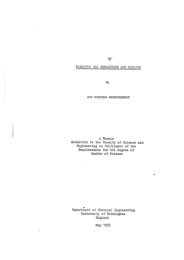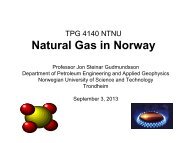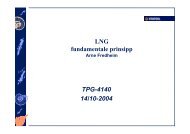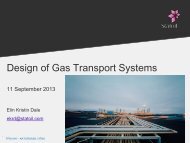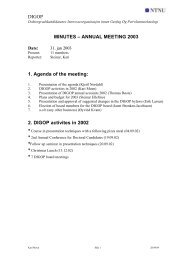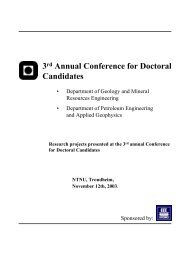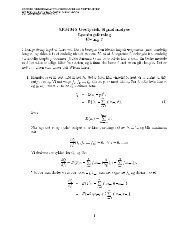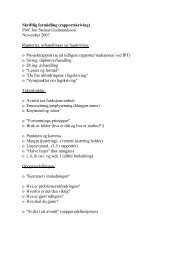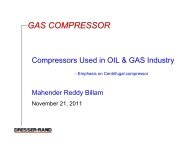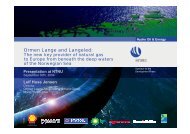Slug Catchers in Natural Gas Production - NTNU
Slug Catchers in Natural Gas Production - NTNU
Slug Catchers in Natural Gas Production - NTNU
You also want an ePaper? Increase the reach of your titles
YUMPU automatically turns print PDFs into web optimized ePapers that Google loves.
Karam – <strong>Slug</strong> <strong>Catchers</strong> <strong>in</strong> <strong>Natural</strong> <strong>Gas</strong> <strong>Production</strong><br />
CHAPTER 6 HYSYS SIMULATIONS<br />
6.1 Model Setup with a close up on the Ormen Lange case<br />
Aspen HYSYS V7.3 has been used to determ<strong>in</strong>e the cont<strong>in</strong>uous amount of gas, liquid and condensate.<br />
The simulations have been implemented for the four different fields <strong>in</strong> question. Therefore, data from<br />
all the fields had to be colleted and used as <strong>in</strong>put for the simulation cases. The basis environment is<br />
built separately for every field, it <strong>in</strong>cludes all the fluid properties of that field. Afterwards, the<br />
flowsheet is built <strong>in</strong> order to connect the streams and the <strong>in</strong>put data together. Many simplifications<br />
have been assumed due to the lack of accurate <strong>in</strong>formation.<br />
Ormen Lange is one of the fields to be <strong>in</strong>vestigated. As a first step, the composition of the field has to<br />
be determ<strong>in</strong>ed <strong>in</strong> order to provide the simulator with the make up of the gas be<strong>in</strong>g <strong>in</strong>vestigated. The<br />
Peng-Rob<strong>in</strong>son fluid package was chosen for the analysis. The model is attributed to a steady-state<br />
model which also reflects a simplified aspect of the model. For further simplifications, all wells and<br />
templates are also assumed to be symmetric <strong>in</strong> position and capacity.<br />
Wet gas has to be ensured <strong>in</strong> the reservoir and <strong>in</strong> its representation <strong>in</strong> the model. To do so, the<br />
reservoir gas stream has to be associated with a stream of water. These two are led to a simple vertical<br />
separation to extract the vapor phase which is used as the ma<strong>in</strong> reservoir stream. The <strong>in</strong>itial reservoir<br />
conditions were specified <strong>in</strong> both the reservoir stream and the water stream. The reservoir temperature<br />
is 96 °C and the reservoir pressure is 290 bars. The setup of the field model is shown <strong>in</strong> Figure 16.<br />
The water flow rate has to be determ<strong>in</strong>ed with precision. This is calculated by the water solubility r sw<br />
which is given <strong>in</strong> Kg/MSm 3 . A VBA has been prepared for that purpose where water mole fraction <strong>in</strong><br />
methane and the water mole fraction <strong>in</strong> gas are calculated to get to the water solubility. The <strong>in</strong>puts to<br />
the VBA are the <strong>in</strong>itial pressure and temperature, the gas gravity and the water sal<strong>in</strong>ity. The gas<br />
gravity <strong>in</strong> the case of the Ormen Lange is 0.6 as for the sal<strong>in</strong>ity, it is assumed to be zero ppm. The<br />
water mass rate, which is 1441 Kg/h, is obta<strong>in</strong>ed from the water solubility and the gas flow rate. It<br />
should be noticed that no formation water is produced at the early stages of production.<br />
The flow rate is one of the ma<strong>in</strong> and essential parameters to be <strong>in</strong>cluded <strong>in</strong> the model as it affects the<br />
model’s performance to a great extent. The total gas flow rate of the field is 70 MSm 3 /d that are<br />
Page 26 of 56



